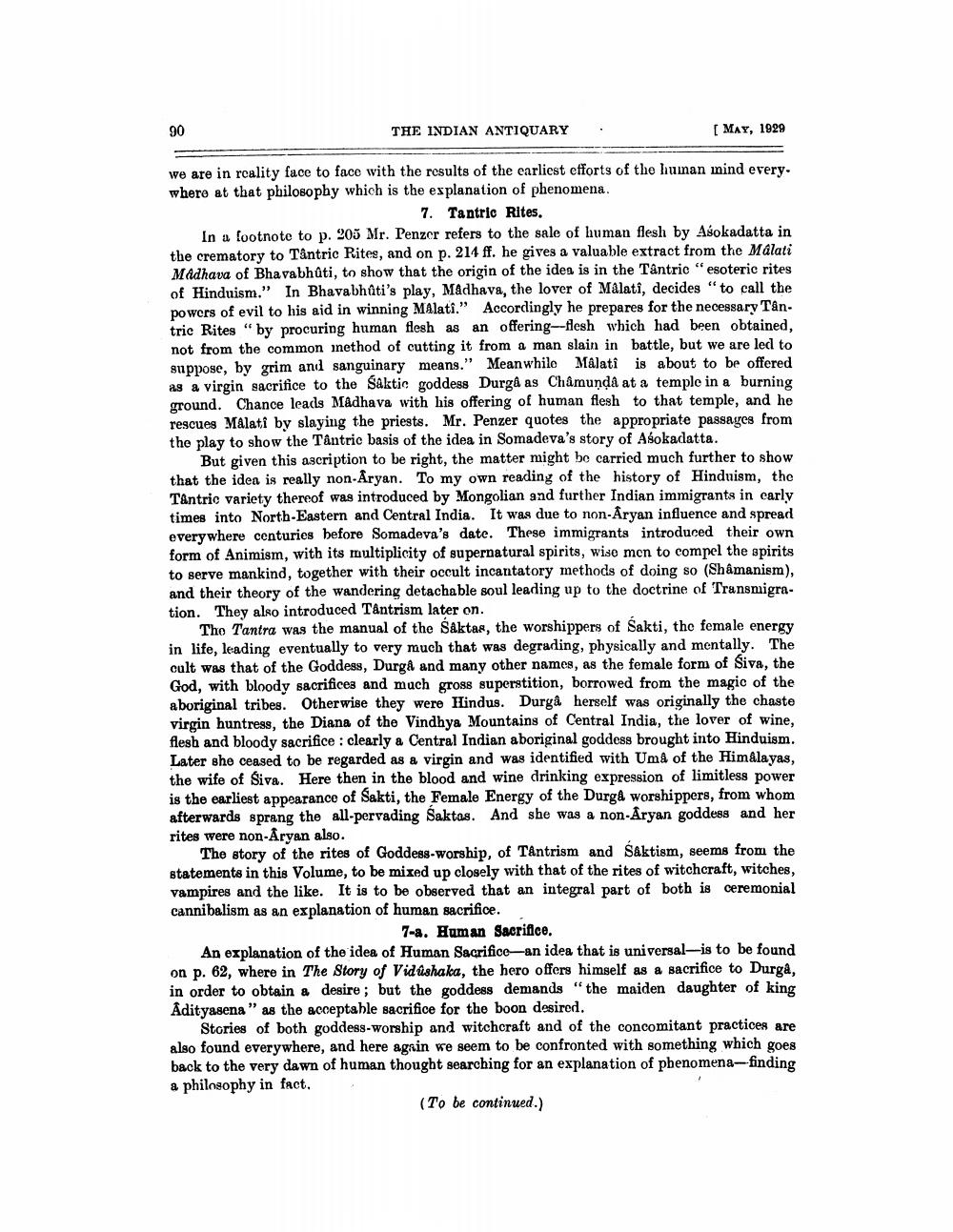________________
90
THE INDIAN ANTIQUARY
.
[ MAY, 1929
we are in reality face to face with the results of the earliest efforts of the human mind every. where at that philosophy which is the explanation of phenomena.
7. Tantric Rites. In a footnote to p. 205 Mr. Penzcr refers to the sale of human flesh by Asokadatta in the crematory to Tântric Rites, and on p. 214 ff. he gives a valuable extract from the Malati Madhava of Bhavabhūti, to show that the origin of the idea is in the Tantric “esoteric rites of Hinduism." In Bhavabhûti's play, Madhava, the lover of Malati, decides "to call the powers of evil to his aid in winning MAlati." Accordingly he prepares for the necessary Tân. tric Rites " by procuring human flesh as an offering--flesh which had been obtained, not from the common inethod of cutting it from a man slain in battle, but we are led to suppose, by grim and sanguinary means." Meanwhile Málati is about to be offered as a virgin sacrifice to the Saktic goddess Durga as Châmundå at a temple in a burning ground. Chance leads Madhava with his offering of human flesh to that temple, and he rescues MAlati by slaying the priests. Mr. Penzer quotes the appropriate passages from the play to show the Tántric basis of the idea in Somadeva's story of Asokadatta.
But given this ascription to be right, the matter might be carried much further to show that the idea is really non-Aryan. To my own reading of the history of Hinduism, the Tântric variety thereof was introduced by Mongolian and further Indian immigrants in carly times into North-Eastern and Central India. It was due to non-Aryan influence and spread everywhere centuries before Somadeva's date. These immigrants introduced their own form of Animism, with its multiplicity of supernatural spirits, wise men to compel the spirits to serve mankind, together with their occult incantatory methods of doing so (Shamanism), and their theory of the wandering detachable soul leading up to the doctrine of Transmigration. They also introduced Tantrism later on.
Tho Tantra was the manual of the Saktas, the worshippers of Sakti, the female energy in life, leading eventually to very much that was degrading, physically and mentally. The cult was that of the Goddess, Durgâ and many other names, as the female form of Siva, the God, with bloody sacrifices and much gross superstition, borrowed from the magic of the aboriginal tribes. Otherwise they were Hindus. Durgå herself was originally the chaste virgin huntress, the Diana of the Vindhya Mountains of Central India, the lover of wine, flesh and bloody sacrifice : clearly a Central Indian aboriginal goddess brought into Hinduism. Later she ceased to be regarded as a virgin and was identified with Uma of the Himalayas, the wife of Siva. Here then in the blood and wine drinking expression of limitless power is the earliest appearance of Sakti, the Female Energy of the Durg& worshippers, from whom afterwards sprang the all-pervading Saktas. And she was a non-Aryan goddess and her rites were non-Aryan also.
The story of the rites of Goddess-worship, of Tantrism and Saktism, seems from the statements in this Volume, to be mixed up closely with that of the rites of witchcraft, witches, vampires and the like. It is to be observed that an integral part of both is ceremonial cannibalism as an explanation of human sacrifice.
7-a. Human Sacrifice. An explanation of the idea of Human Sacrifice-an idea that is universal-is to be found on p. 62, where in The Story of Vidushaka, the hero offers himself as a sacrifice to Durga, in order to obtain a desire ; but the goddess demands "the maiden daughter of king Adityasena" as the acceptable sacrifice for the boon desired.
Stories of both goddess-worship and witchcraft and of the concomitant practices are also found everywhere, and here again we seem to be confronted with something which goes back to the very dawn of human thought searching for an explanation of phenomena-finding a philosophy in fact,
(To be continued.)




